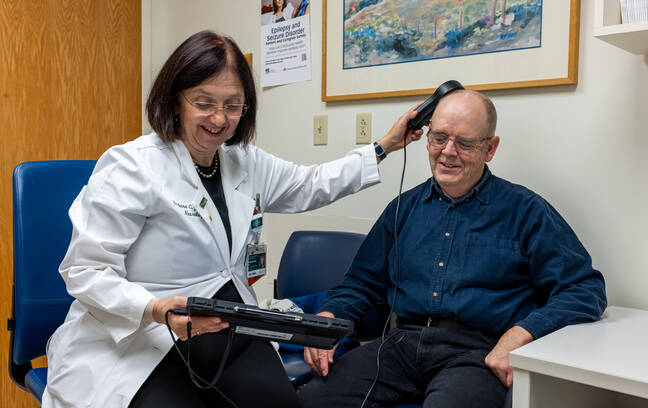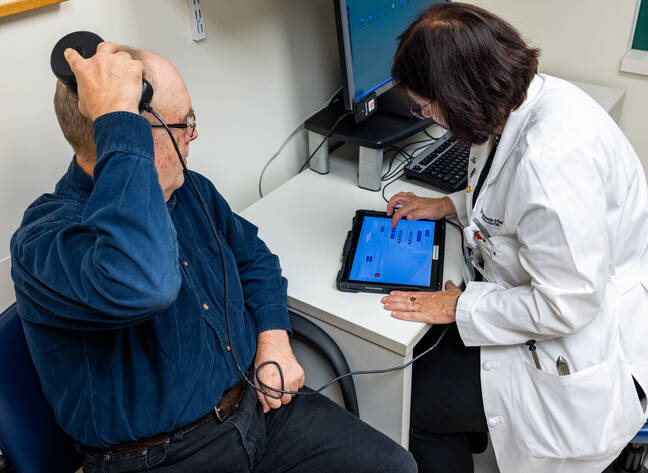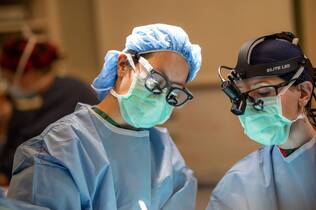We may diagnose you with refractory epilepsy if you continue to have seizures while taking medication.
Learn more about our tests and treatments for refractory epilepsy:
Refractory epilepsy tests
To determine the best treatment for refractory epilepsy, we may order the following tests:
- Neuropsychological testing: This test is done as an outpatient and may take up to 6 hours. You meet with a neuropsychologist who administers standardized cognitive testing. This testing may include tests of memory, verbal skills, and visuospatial skills.
- Functional MRI: Similar to the 3T MRI with epilepsy protocol, this test takes about 1 hour to complete. It allows us to determine where important language regions are in your brain.
- Ictal SPECT: Some patients with refractory epilepsy may need a second 3-5 days admission to our Epilepsy Monitoring Unit at DHMC. During this test, we inject a safe radioactive dye into your vein during a seizure and then take a picture with specialized equipment.
- Wada test: This test gives us information on how epilepsy surgery may affect your speech and memory. It's an outpatient test at DHMC that takes about 2-3 hours to complete. We inject sleeping medication through a vein in your leg, which puts half of your brain to sleep while we test your speech and memory.
- Intracranial EEG: Some patients with refractory epilepsy who are being evaluated for brain stimulation or brain surgery may need a recording of their seizures using electrode sensors that have been placed through the skull into their brain. We will refer you to a neurosurgeon who will explain and perform the test. You will be admitted to the hospital for about 10 days, during which you will undergo general anesthesia, and the surgeon will place tiny electrode sensors in the part of the brain that causes seizures. After this surgery, we will admit you to our Epilepsy Monitoring Unit, reduce your medications and record any seizures.
- PET scan: Similar to a 3T MRI test, a PET scan takes about 2 hours to perform. This test gives images of the metabolic activity of the brain.
Refractory epilepsy treatments
We specialize in the most up-to-date treatment of refractory epilepsy. Such treatment may include:
- Brain stimulation (DBS, RNS, and VNS).
- Brain surgery (ablation or resection).
- Dietary therapy (ketogenic diet).
- Investigational medication.
Brain stimulation
We may recommend a type of treatment called brain stimulation. Currently, three different types of brain stimulation are available to people with epilepsy:
- Deep brain stimulator (DBS): This device is an electrical generator implanted under the collarbone and connected by a wire to a sensor that goes inside your brain. The sensor lies in a part of the brain called the thalamus. Stimulating the thalamus with a small amount of electricity that you do not feel reduces seizures in many situations.
- Responsive Neurostimulation (RNS): This device is an electrical generator implanted in the bone of the head (that is, the skull) that sends electrodes to parts of the brain that cause seizures.
- Vagus nerve stimulator (VNS): This device is an electrical generator implanted under the collarbone and connected by a wire to the vagus nerve in the neck. Stimulating this nerve with a small amount of electricity has proven to reduce some types of seizures. It can be activated by holding a magnet over the implanted generator.
Brain surgery
Brain surgery for epilepsy (or epilepsy surgery) has been used in the United States since the 1950s and at our Epilepsy Center since the 1990s. It is an epilepsy treatment practiced around the world and done by a neurosurgeon who is trained to perform it.
There are two main types of epilepsy surgery, each having advantages:
- Ablation (same as laser ablation). Laser ablation is available to some patients with refractory epilepsy. It's best for patients who have a well-defined and small region of the brain that causes seizures. These are patients that have temporal lobe epilepsy with hippocampal sclerosis. The advantage of laser ablation is that it is minimally invasive. Typically, the patient can be discharged within 24 hours of the surgery. The surgeon makes a small hole in the patient's skull during this surgery. The surgeon then passes a laser through the hole to an advanced brain area, causing the seizures.
- Resection. A neurosurgeon does resection (or open surgery). During this type of surgery, a surgeon removes a small part of the brain that causes seizures. To do this, the surgeon temporarily removes a part of the skull, enters the brain, and removes the sick brain region that causes seizures. Typically, the size of the removed area is larger than what is removed during ablation.
After surgery, we will follow your progress and recovery very closely. You must tell us if you have any problems functioning or have trouble coping with a life without epilepsy. These are very important concerns, and our team can help you.
- You will see your neurologist and neurosurgeon about four to six weeks after surgery.
- Your team will follow up with you every three months for the first year, then every six months thereafter.
Although epilepsy surgery is considered relatively safe, there are certain risks, which may include:
- Bleeding or infection at the surgical site.
- Difficulty remembering or speaking certain words.
- Minor vision loss or weakness opposite the side of surgery.
- Risks associated with anesthesia.
Dietary therapy
If you have refractory epilepsy, we may refer you to a trained dietitian for the ketogenic diet. This diet is intended for patients one year or older with frequent seizures who do not respond well to anti-seizure medications.
The diet comprises fats with small amounts of protein, carbohydrates, and fluids. Most patients have fewer seizures on this diet, although results vary.
Investigational medication
You may be referred to a clinical trial for clinical research of an experimental drug.


